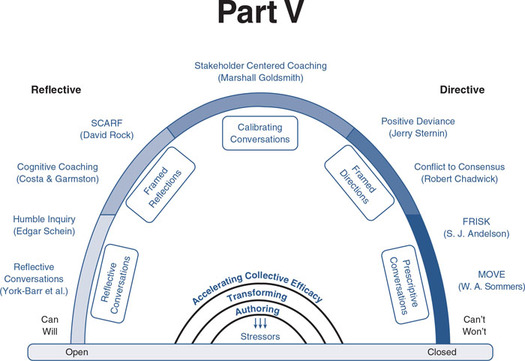Part V PartTitle

Urban Luck Design, urbanluckdesign.com
In many ways, Bill and Diane still have unrealized dreams. We no longer work daily in schools, yet we care passionately about learning. We wonder what it would have been like if we had known what we know now. Almost every day, we think of recommitting and returning to the daily work of schools—we miss it.
We think about how if we had it to do over again, we would sit down sooner, spend more time listening than talking, and seek out the tacit knowledge of teachers as a way of building knowledge legacies. We now invite you to join us in surveying the landscape of schooling; how might you apply what you have learned within these pages to accelerate collective efficacy?
This journey is not for the faint of heart, and each of you will surly stumble as we did. Know that you are not alone, and if you just reach out, you will find others who willingly will join the journey. When humans struggle together and learn to solve the most difficult challenges, they develop a sense of collective capability that anything is possible. They find satisfaction and renewal in their work and are less swayed by the passing fads, enjoying more control over their professional destinies.
The moral imperative weighs on all of us; how long can we wait? Not long—our students deserve the future we are capable of producing, not something that someone long ago thought was tried and true. The key is to understand that we are ultimately responsible for our own personal learning trajectory. Leaders must seek more and more ways to turn the responsibility for learning back to the participants and to hold them accountable to produce actionable learning. Likewise, teachers can apply what they are learning about their own learning to the classroom. Students can tell when adults care deeply about their craft in the ways they pass on that wisdom.
As part of this process, teachers not only question each other, but they learn to question the experts and to seek ever-greater understanding about what makes a difference in the learning of students. When professionals know what they stand for, can articulate how they make a difference for students, and are willing to question each other to find central truths, they create a professional narrative of excellence. When schools make it a priority to make time for quality conversations that matter, teachers engage in more contemplative thoughts about teaching and learning. Each one of the Nine Conversations outlined in this book opens a different door for deep reflection about what really matters for teachers. Furthermore, each one of these Nine Conversations can also be used in classrooms to invite students to reflect on their own learning trajectories.
The old model of an enlightened professional leading the way is no longer sufficient. Teaching and learning have become way too complex to depend on just a few in charge; all must engage and become contributing experts in their own way. Over time, part of the professional repertoire should be about how to engage in these types of quality conversations. Only then can teachers take control of their own professional development and insist that the implementation of mandates from outside be considered carefully and embedded in practice through a process of reflecting in–on–for action. It is this reciprocal process that will make the difference and give the profession back its voice. Not only will educators be rewarded with better working relationships, but they will find that all of these reflective practices can also be used with students.